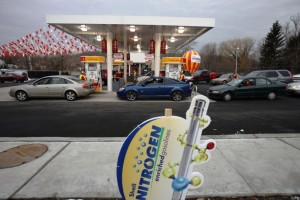
With demand down, look for more gasoline marketing campaigns as the weather warms.
There’s nothing like a free tank of gasoline to cause a commotion at a gas station. That’s precisely what happened last Friday, when Shell kicked off its latest line of gasolines. Driver’s lined up to try the new fuel in seven commuter markets, including New York City, Los Angeles, Washington DC, Seattle, Houston, Jacksonville, and Cincinnati. Throughout the week of March 2, local radio stations hinted where the participating gasoline stations were. Then, finally, on Friday morning listeners were actually told where tanks would be filled for free from 7 to 9 a.m.
The gasoline market is tougher these days. Cumulative travel for 2008 changed by -3.6 percent (-107.9 billion vehicle miles), according to the Federal Highway Administration. But we still consume lots of fuel since Americans traveled an estimated 2,921.9 billion vehicle miles last year. So this is a market worth fighting over. Even though gasoline prices are down nationally on average to under $2 a gallon from $3.20 a year ago, according to AAA, demand is also way down as the Great Recession continues. Worse, from a brand promotion point of view, I speculate that virtually all consumers –who have been battered by outrageous increases during the last couple of years — are shopping price, then price, and not quality, a completely rational response.
Advertising to the Rescue
Shell’s good, old-fashioned publicity stunt was created to hype Shell Nitrogen Enriched Gasolines. Shell claims that nitrogen is a new and key ingredient of the additive package in all three of its gasoline grades. Nitrogen is said to be more stable at higher combustion chamber temperatures common in late model engines. This increased stability resists breakdown better than conventional cleaning additives and is said to remove carbon deposits on intake valves and fuel injectors left behind by lower quality gasolines. Shell is supporting the launch of Nitrogen Enriched Gasolines with a national marketing campaign, including TV, radio and online advertising, as well as point-of-purchase marketing at Shell-branded stations.
Thus the latest shot was fired in the ongoing gasoline marketing wars. Virtually all major branded gasolines in the U.S. have additive packages and use marketing claims of cleaner running engines from their use, among other touted benefits. Well, maybe so, but maybe not.
AAA, a non-profit automobile club with more than 50 million members, is cautious about, but not dismissive of such claims. A spokeswoman for AAA told TheDetroitBureau the first thing to check is your owner’s manual for the recommended octane rating. Most engines need 87 octane. Some performance models engines are designed for levels of 89, 91 or higher. Ordinarily, your vehicle will not benefit from using a higher octane, more expensive gasoline than recommended. But if your engine knocks or pings at the recommended level, you may need higher octane to prevent the knock. This doesn’t mean that other special additive packages from brands claiming better engine performance or greater driving satisfaction won’t work for you. It means you have to make up your own mind.
Shell, along with other makers, including Chevron, Conoco, Petro-Canada, Phillips 66, Texaco, 76 and many independents, take this marketing a step further. They all claim their additive packages remove carbon more effectively than gasolines containing only the minimum amount of cleaning agents as required by the EPA. These fuels are certified to meet the so-called “Top Tier Gasoline” standards – endorsed by Audi, BMW, GM, Honda, Toyota and Volkswagen — to improve fuel quality beyond the Environmental Protection Agency criterion for engine cleaning detergent.
Significant by their absence from this promotional club are Exxon, “Our quality gasolines are available in three octane grades, all with high levels of detergents that help protect against fuel injector and intake valve deposits. And all of our gasolines provide power, easy startup and help minimize emissions in your vehicles;” Mobil, “All our gasolines contain effective detergent additives;” and British Petroleum’s “Invigorate,” which “can help a dirty engine get back some of its new engine performance, including restored fuel economy, smoother acceleration and lower emissions.”
The Top Tier Gasoline marketers claim that since minimum additive performance standards were first established by EPA in 1995, most gasoline marketers have actually reduced the concentration of detergents in their gasoline by as much as 50%. As a result, the ability of a vehicle to maintain emission standards have been hampered, leading to engine deposits which can negatively affect emissions, engine performance and driver satisfaction.
This is not at all clear to me: Why would the EPA allow gasoline to be sold if it increases the emissions of auto engines? I prefer to look at it the other way around: Why would carmakers design engines that can perform badly on EPA specified fuel? Well, consider this: carmakers face costly recalls under emission regulations if your “check engine” light comes on too many times. So there’s some self-interest in making sure that doesn’t happen by building a little margin into the fuel you buy just in case a maker’s design is marginal, or are parts sub-standard, or manufacturing can’t hold tolerances.
No matter: Expect more gasoline advertising campaigns from other brands as spring arrives. As to me, I usually shop price from a brand I know. So you pays your money and you takes your choice.
Click here for AAA’s Fuel Gauge Report
Click here for more information on Top Tier Gasolines
Click here for more information from Shell
